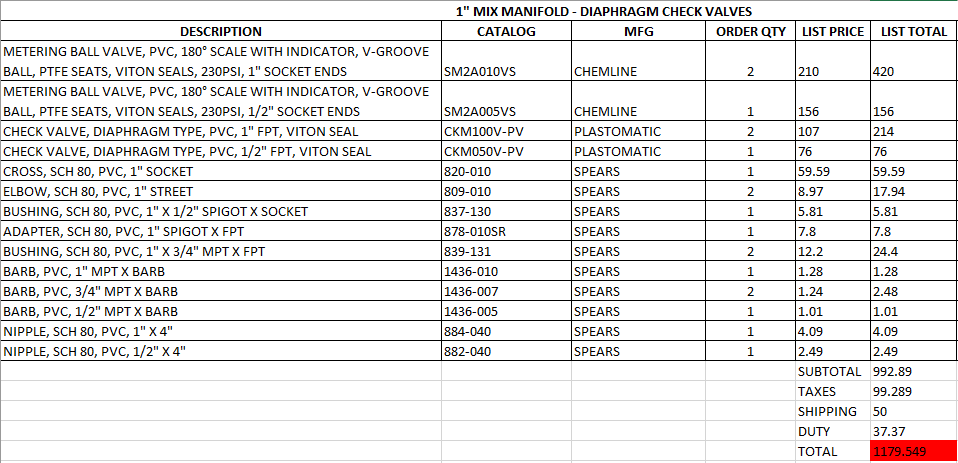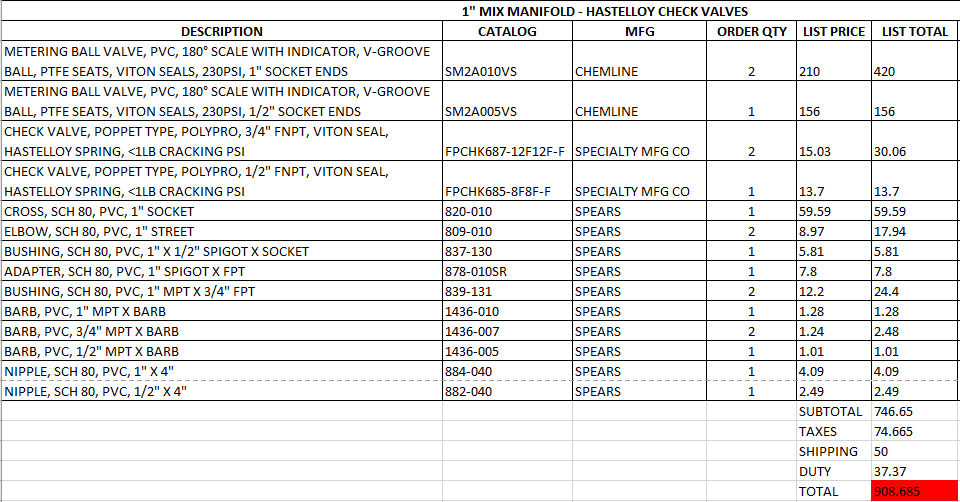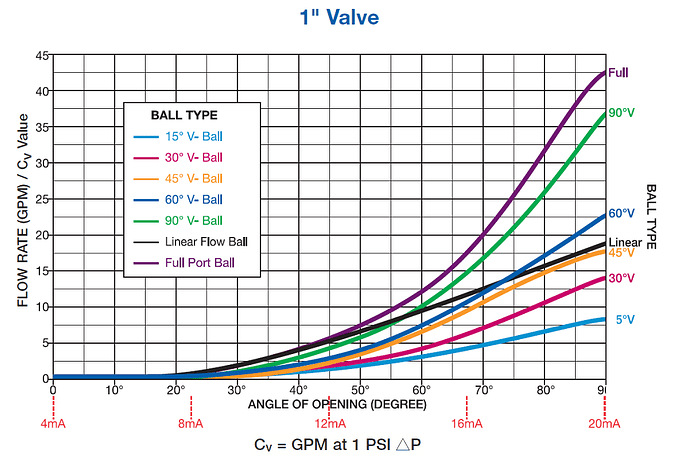We’re cool. 
@tireshark, @getherdone, @BlueLineWash, @ProClean_Plus, @PointExteriors and everyone else who is interested:
COMPONENT LIST WITH PRICING
I’ve invested a lot of work in all this. You may be able to shop around and find a few of the components or fittings cheaper than list pricing online. But I’ll be able to sell all the systems either at or below what it’d cost to buy all the parts yourself. I’m not listing pricing for the PVC pipe required for the manifold, but if you wanted to do it yourself, you’d need to buy the pipe and cut it and glue everything and do the full assembly too.
I don’t think you could build it yourself for as cheap as I can build and sell it actually. Anyway, I’d just appreciate no one taking advantage of me sharing everything or trying to undercut me by taking all my work and selling it as your own. But in all honestly, you probably can’t get the pricing I do on parts, so it’s unlikely anyway.
great work! I saw earlier you had a parts list for the 3/4" system with Diaphram check valves. If i were to purchase this from you. How much would it be?
PM’d you.
I had accidentally posted the 1" info twice. I fixed it to have both 1" and 3/4" info.
Adapters!!
I’ve only read about 2 posts in this thread as I don’t have the attention span to read more than a couple of sentences. But, kudos for sharing knowledge
mark me down for a 3/4inch Diaphragm check valve system for 900$
@tireshark, this is what I just shipped out to you. Both metering systems, a flowmeter up to 17 GPM, and all the barbs you might need. The flow meter has 1" barbs on both ends, FYI, and it only works if it’s mounted vertically and water flows bottom to top. I’m sure you knew this already though. I was imagining just zip-tying it to a post or board or something temporary for testing. (I’ll need it back lol.)
There are barbs and bushings to try 1" and 3/4" inlets for the 1" metering valves. I loosed the true unions on the valves and rotated things and left the barbs off the inlets and outlets so it would fit better in a smaller box for shipping. They can just be straightened and tightened when you get them.
I’m super excited for you to get to use them and do some testing.
(@tireshark is adding check valves on his own because I hadn’t figured that part out yet when he ordered this one.)
Check valves came into day. Hastelloy spring type. 3/4" and 1/2" for a 1" metering system. They are really nice, and I was actually impressed. I do think this might be a better option over the diaphragm check valves because they are so inexpensive compared to the diaphragm check valves. You could even keep a few spares on hand and still be cheaper than going with the diaphragm check valve setup. The only thing is that the largest size is 3/4", but it’s not very restrictive, so that shouldn’t be an issue.
i might go with these in the 3/4inch system you had me marked down for. With the price i think its better to go with these over the diaphragms
Sure thing. These look really nice, personally when I built my own system, I think I’ll use these as well.
So here’s a non-true metering ball valve that’s available with a linear cut ball. It is not a metering valve as much as the Chemline metering valves, but it allows the same thing. I know the large cost of the Chemline valves is really an issue and accounts for basically like 2/3 of the cost of the metering system, so I’m looking at other options to consider.
With people discussing using the banjo micro valves, it seems like that having precision control over ratios isn’t as crucial as I thought it was and people are more concerned with the general ratio instead. That’s great. Plastomatic makes a ball valve with a 90 degree scale on it, so it’s a 1/4 turn ball valve, but they give you the option of selecting different balls inside of the valve to give the curve desired, and the nice this is that they put the flow curves for angle open for each size valve they have.
Below are their curves for 3/4" and 1" valves, and you can see each ball cut compared to a full port ball valve to see how the flow compares. These valves do come with the scale, so with some math in excel, it’d be pretty easy to figure out relative ratios of SH and water based on degrees open. And the linear cut ball has a really nice, nearly straight curve to it that would make everything repeatable.
These valves are significantly cheaper, would have higher flow rates (less restrictive) and still have a scale for “metering”. The issue would be that it may not be as accurate because it’s not a true metering valve, but maybe that’s a fair trade off.
I’ve seen these valves before, and I think @tireshark has shown me them as well, but I had ruled them out because you lose a lot of resolution and precision with 90 degrees of opening instead of 180 and the non-true metering ball, and I thought that was important. Maybe it’s not as important as I first thought?
I asked for a quote on pricing for these valves in 1/2", 3/4" and 1" with the linear cut ball for comparison with the Chemline valves. The metering system design would all stay the same, and this valve would just take the place where the Chemline valves originally would go. No design changes or anything. It’d be a direct part number swap.
What do you guys think?
personally i’m gonna stick with the ChemLine valves
Compare to the Chemline metering valves Cv value. The Chemline 3/4" has a Cv value of almost 2 at full open. The Plastomatic Linear Cut valve 3/4" has a Cv value of 12 at full open. To me, that sounds like a much less restrictive flow.

Here’s the Cv curve for the GF 523 metering valves. If you look at the max value for 1/2", you’ll see that it’s 1.4 GPM. If you compare that to the Chemline 1/2" metering valve, you’ll see that it’s also at 1.4 GPM. Both the GF 523 and Chemline metering valves have the v-groove metering ball inside.
Compare both of these values to the Plastomatic Linear Cut 1/2" valve and it’s at 4.3 GPM. If I am interpreting this correctly, it looks like the Plastomatic valve with linear cut ball allows 3X the amount of flow through with the same pressure loss across the valve.
Note that earlier I posted the Cv curves for the plastomatic 3/4" and 1" valves as well, each of which includes the curve of the full port balls, linear cut balls, and all the other v cut options, with linear obviously being the most linear.
In my opinion, this could potentially be a better option than going with the 1" or 3/4" Chemline valves. Yes, those valves have a long lead time which is annoying, but also, it looks like maximum flow potential could be achieved with a 3/4" valve, allowing up to 11 GPM through one single valve with minimum pressure loss across the valve.
I suppose the only way to really know though would be to test a setup with these valves also though. Maybe that’s what I’ll do next.
How can I order a 3 valve setup? And how much would it cost me to have it shipped to Louisiana?
Update on the Plastomatic valves. I don’t think they are feasible. They have a 4-5 week lead time and they are more expensive than the Chemline metering valves. Here is a screenshot of the quote, and that’s my discounted rate price. 1/2", 3/4", and 1" valves are quoted here.
Just thought I’d share for everyone to see.















